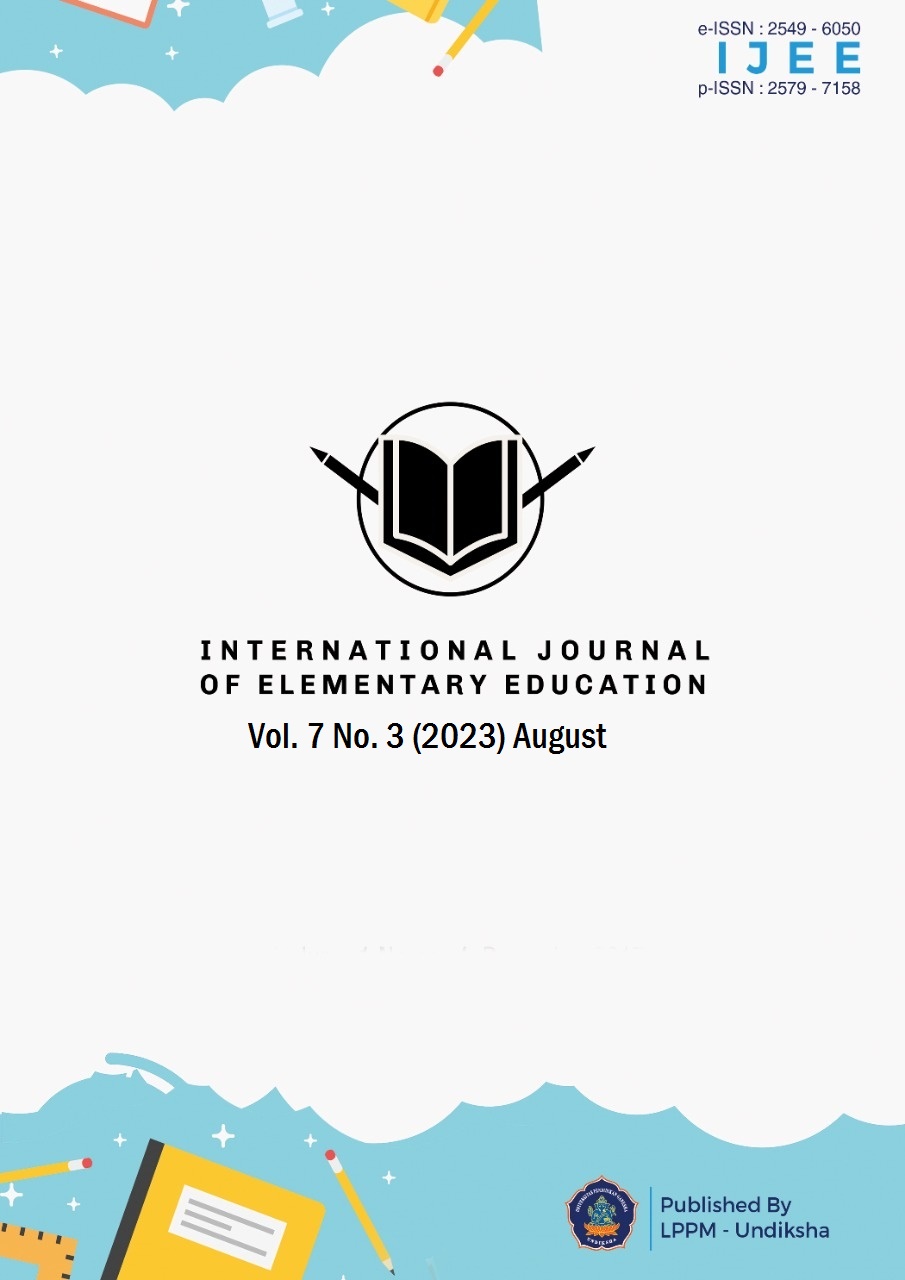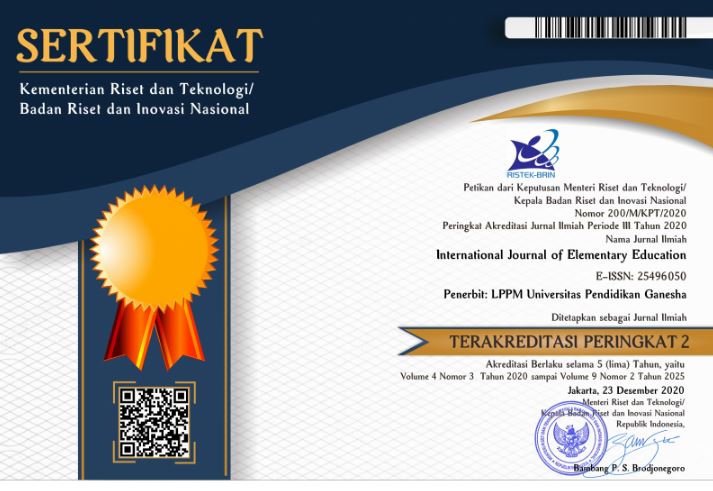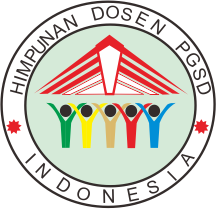Implementation of Basic Literacy Models for Elementary School Students
DOI:
https://doi.org/10.23887/ijee.v7i3.55228Keywords:
Basic Literacy, Implementation Coverage, Exploratory DescriptiveAbstract
One of the efforts made by the government to implement an independent curriculum is to create a School Literacy Movement. This program is implemented to foster students' interest in reading and can improve reading skills to master knowledge better. Various obstacles arose regarding the implementation of the Basic Literacy Movement program in elementary schools. This study aims to analyze the coverage of the implementation of the basic literacy model in elementary schools. The method in this study uses a qualitative approach with an exploratory descriptive design. The source of data in this study is an elementary school. The data collection techniques are carried out by observation, and documentation. The data analysis techniques include data reduction, data display, and data verification. The test of validity data using technical triangulation. The results showed that the coverage of the implementation of the literacy model was 100%, the numeracy literacy model was 100%, the scientific literacy model was 50%, the digital literacy model was 64.10%, the financial literacy model was 41.02%, and the civics cultural literacy model was 100%. The conclusion in this study is that the basic literacy movement in elementary schools is carried out with several activities including literacy, numeracy, science, finance, digital, and culture. It is hoped that future research can pay more attention to literacy models that have not yet achieved basic literacy implementation, so that the embodiment of the school literacy movement can be achieved more proportionally and comprehensively.
References
Akintolu, M., & Uleanya, C. (2021). Ensuring Sustainable Development Goal in Rural Africa through Adult Literacy Programme: A Case Study of Technology Usage in Developing Nations. Universal Journal of Educational Research, 9(4), 713–719. https://doi.org/10.13189/ujer.2021.090401. DOI: https://doi.org/10.13189/ujer.2021.090401
Antoro, B., Boeriswati, E., & Leiliyanti, E. (2021). Pelaksanaan Gerakan Literasi Sekolah Di Sekolah Menengah Pertama. Jurnal KIBASP (Kajian Bahasa, Sastra Dan Pengajarangajaran, 5(1), 1–15. https://doi.org/10.31539/kibasp.v5i1.2474. DOI: https://doi.org/10.31539/kibasp.v5i1.2474
Arifin, Z., & Setiawan, B. (2022). Exploring students’ literacy of information technology in higher education: Platforms and usage. Cypriot Journal of Educational Sciences, 17(3), 859–872. https://orcid.org/0000-0001-6497-3280. DOI: https://doi.org/10.18844/cjes.v17i3.6877
Batubara, H. H., & Ariani, D. N. (2018). Implementasi Program Gerakan Literasi Sekolah Di Sekolah Dasar Negeri Gugus Sungai MIAI Banjarmasin. Jurnal Pendidikan Sekolah Dasar, 4(1), 15–29. https://doi.org/10.30870/jpsd.v4i1.2965. DOI: https://doi.org/10.30870/jpsd.v4i1.2965
Belzer, A. (2017). Reflections on the PIAAC literacy and numeracy frameworks. Adult Learning, 28(3), 118–120. https://doi.org/10.1177/1045159516655150. DOI: https://doi.org/10.1177/1045159516655150
Cahyanovianty, A. D., & Wahidin. (2021). Analisis Kemampan Numerasi Peserta Didik Kelas VIII dalam Menyelesaikan Soal Asesmen Kompetensi Minimum. Jurnal Cendekia: Jurnal Pendidikan Matematika, 05(02), 1439–1448. https://doi.org/10.31004/cendekia.v5i2.651.
Chellman, D. J. (2019). Adult ethical development in Christian congregations: A phenomenological study of pastors’ perception. New Horizons in Adult Education and Human Resource Development, 31(2), 5–26. https://doi.org/10.1002/nha3.20246. DOI: https://doi.org/10.1002/nha3.20246
Chen, X. (2022). Adult literacy policy and practice in post-1949 China: A historical perspective. In Studies in the Education of Adults (pp. 1–18). https://doi.org/10.1080/02660830.2022.2076312. DOI: https://doi.org/10.1080/02660830.2022.2076312
Dafit, F., & Ramadan, Z. H. (2020). Pelaksanaan Program Gerakan Literasi Sekolah (GLS) di Sekolah Dasar. Jurnal Basicedu, 4(4), 1429–1437. https://doi.org/10.31004/basicedu.v4i4.585. DOI: https://doi.org/10.31004/basicedu.v4i4.585
Dharma, K. B. (2020). Implementasi gerakan literasi sekolah dalam menumbuhkan minat baca siswa sekolah dasar. Jurnal Edukasi Nonformal, 1(1), 70–76. https://ummaspul.e-journal.id/JENFOL/article/view/403.
Hasni, L., Witono, A. H., & Khair, B. N. (2022). Peran Guru Dalam Menciptakan Budaya Literasi Melalui Gerakan Literasi Sekolah (GLS) Di Kelas IV MI Darul Hikmah Darek. Journal of Classroom Action Research, 4(3), 60–66. https://doi.org/10.29303/jcar.v4i3.1893.
Hidayat, M. H., Basuki, I. A., & Akbar, S. (2018). Gerakan Literasi di Sekolah Dasar. Jurnal Pendidikan, 3(6), 810–817. https://doi.org/10.17977/jptpp.v3i6.11213.
Holloway, S. M., & Gouthro, P. A. (2020). Using a multiliteracies approach to foster critical and creative pedagogies for adult learners. Journal of Adult and Continuing Education, 26(2), 205–218. https://doi.org/10.1177/1477971420913912. DOI: https://doi.org/10.1177/1477971420913912
Ilmi, N., Wulan, N. S., & Wahyudin, D. (2021). Gerakan Literasi Sekolah dalam Meningkatkan Minat Baca Siswa Sekolah Dasar. Edukatif: Jurnal Ilmu Pendidikan, 3(5), 2866–2873. https://doi.org/10.31004/edukatif.v3i5.990. DOI: https://doi.org/10.31004/edukatif.v3i5.990
Khotimah, K., Akbar, S., & Sa’dijah, C. (2018). Pelaksanaan Gerakan Literasi Sekolah. Jurnal Pendidikan: Teori, Penelitian, Dan Pengembangan, 3(11), 1488–1498. http://download.garuda.kemdikbud.go.id/article.php?article=921953&val=9626&title=Pelaksanaan Gerakan Literasi Sekolah.
Klauth, B., & Mitchell, R. L. (2022). Transforming lives through a literacy program: An exploration of adult learners’ experiences. Journal of Adult and Continuing Education, 23(2), 181–193. https://doi.org/10.1177/14779714221087277. DOI: https://doi.org/10.1177/14779714221087277
Kolawole, O. D., & Pusoetsile, T. (2022). What difference does literacy make among adult learners? Impact of adult basic education programme in a rural community in Botswana. Journal of Adult and Continuing Education, 28(1), 227–251. https://journals.sagepub.com/doi/abs/10.1177/1477971421100. DOI: https://doi.org/10.1177/14779714211007495
Kuswanti, H., & Ulfah, M. (2021). Gerakan literasi finansial di SMA Kabupaten Kubu Raya Kalimantan Barat. Ekuitas: Jurnal Pendidikan Ekonomi, 9(1), 1–8. http://journal.um.ac.id/index.php/jptpp. DOI: https://doi.org/10.23887/ekuitas.v9i1.32710
Labudasari, E., & Rochmah, E. (2019). Pengaruh gerakan literasi sekolah terhadap karakter mandiri siswa di SDN Kanggraksan Cirebon. Premiere Educandum : Jurnal Pendidikan Dasar Dan Pembelajaran, 9(1). https://doi.org/10.25273/pe.v9i1.4254. DOI: https://doi.org/10.25273/pe.v9i1.4254
Laila, V., Hadi, S., & Subanji, S. (2019). Pelaksanaan pendidikan literasi finansial pada siswa sekolah dasar. Jurnal Pendidikan: Teori, Penelitian, Dan Pengembangan, 4(11), 1491–1495. https://doi.org/10.17977/jptpp.v4i11.13016. DOI: https://doi.org/10.17977/jptpp.v4i11.13016
Mas, S. R., Daud, N. K. P., & Djafri, N. (2019). Evaluasi pelaksanaan program gerakan literasi sekolah di sekolah dasar negeri. JMSP (Jurnal Manajemen Dan Supervisi Pendidikan, 4(1), 45–51. https://doi.org/10.17977/um025v4i12019p045. DOI: https://doi.org/10.17977/um025v4i12019p045
Naveed, M. A., & Mahmood, M. (2022). Correlatives of business students’ perceived information literacy self-efficacy in the digital information environment. Journal of Librarianship and Information Science, 54(2), 294–305. https://doi.org/10.1177/09610006211014277. DOI: https://doi.org/10.1177/09610006211014277
Nopilda, L., & Kristiawan, M. (2018). Gerakan Literasi Sekolah Berbasis Pembelajaran Multiliterasi Sebuah Paradigma Pendidikan Abad Ke- 21. JMKSP (Jurnal Manajemen, Kepemimpinan, Dan Supervisi Pendidikan), 3(2). https://doi.org/10.31851/jmksp.v3i2.1862. DOI: https://doi.org/10.31851/jmksp.v3i2.1862
Novarina, G. E., Santoso, A., & Furaidah, F. (2018). Model Pelaksanaan Gerakan Literasi Sekolah di Sekolah Dasar. Jurnal Pendidikan: Teori, Penelitian, Dan Pengembangan, 4(11), 1448–1456. https://doi.org/10.17977/jptpp.v4i11.12989. DOI: https://doi.org/10.17977/jptpp.v4i11.12989
Oktavia, N., & Rahmawati, L. E. (2021). Meningkatkan Kompetensi Menulis Teks Prosedur melalui Pemanfaatan Video Youtube pada Mata Pelajaran Bahasa Indonesia. Pedagogie, 16(1), 15–20. https://doi.org/10.31603/paedagogie.v16i1.4986. DOI: https://doi.org/10.31603/paedagogie.v16i1.4986
Patterson, M. B. (2018). The Forgotten 90%: Adult nonparticipation in education. Adult Education Quarterly, 68(1), 41–62. https://doi.org/10.1177/0741713617731810. DOI: https://doi.org/10.1177/0741713617731810
Perdana, R., & Suswandari, M. (2021). Literasi Numerasi Dalam Pembelajaran Tematik Siswa Kelas Atas Sekolah Dasar. Absis: Mathematics Education Journal, 3(1), 9. https://doi.org/10.32585/absis.v3i1.1385. DOI: https://doi.org/10.32585/absis.v3i1.1385
Pradana, B. H., Fatimah, N., & Rochana, T. (2017). Pelaksanaan Gerakan Literasi Sekolah Sebagai Upaya Membentuk Habitus Literasi Siswa Di Sma Negeri 4 Magelang. Solidarity: Journal of Education, Society and Culture, 6(2), 167–179. https://journal.unnes.ac.id/sju/index.php/solidarity/article/view/19560.
Prasetia, I., Sulasmi, E., & Sugiharti, S. (2022). Pengaruh Program Gerakan Literasi dan Sarana Perpustakaan Terhadap Budaya Literasi di Sekolah Dasar. Jurnal Manajemen Pendidikan Dasar, Menengah Dan Tinggi (JMP-DMT, 3(1), 21–27. http://dx.doi.org/10.30596%2Fjmp-dmt.v3i1.9337
Puspasari, I., & Dafit, F. (2021). Implementasi Gerakan Literasi Sekolah di Sekolah Dasar. Jurnal Basicedu, 5(3), 1390–1400. https://doi.org/10.31004/basicedu.v5i3.939 DOI: https://doi.org/10.31004/basicedu.v5i3.939
Rahmawati, L. E., Prayitno, H. J., Wahyudi, A. B., Pratiwi, D. R., Suyitno, D. N., Beauty, M., & Lestari, W. D. (2022). Pendampingan Penguatan Literasi Digital di SD Muhammadiyah Program Khusus Baturan dan SD Muhammadiyah Plus Malangjiwan. Warta LPM. https://journals2.ums.ac.id/index.php/warta/article/view/617. DOI: https://doi.org/10.23917/warta.v25i4.617
Sa’diyah, D., Hendratno, H., & Subrata, H. (2022). Implementasi Gerakan Literasi Sekolah melalui Model Problem Based Learning Siswa Kelas Sekolah Dasar. Jurnal Basicedu, 6(5), 8115–8130. https://doi.org/10.31004/basicedu.v6i5.3746. DOI: https://doi.org/10.31004/basicedu.v6i5.3746
Safitri, I., Marsidin, S., & Subandi, A. (2020). Analisis Kebijakan terkait Kebijakan Literasi Digital di Sekolah Dasar. Edukatif : Jurnal Ilmu Pendidikan, 2(2), 176–180. https://doi.org/10.31004/edukatif.v2i2.123. DOI: https://doi.org/10.31004/edukatif.v2i2.123
Salma, A. (2019). Analisis Gerakan Literasi Sekolah Terhadap Minat Baca Siswa Siswa Sekolah Dasar. Mimbar PGSD Undiksha, 7(2), 1–10. https://doi.org/10.23887/jjpgsd.v7i2.17555.
Sholeha, V., Wahyuningsih, S., Hafidah, R., Syamsuddin, M. M., Pudyaningtyas, A. R., Dewi, N. K., & Nurjanah, N. E. (2021). Penerapan Literasi Sains Basis Kelas oleh Guru PAUD di Kota Surakarta. Jurnal Obsesi: Jurnal Pendidikan Anak Usia Dini, 6(3), 2013–2019. https://doi.org/10.31004/obsesi.v6i3.1237. DOI: https://doi.org/10.31004/obsesi.v6i3.1237
Sutrisna, I. P. G. (2020). Gerakan literasi digital pada masa pandemi covid-19. Stilistika: Jurnal Pendidikan Bahasa Dan Seni, 8(2), 269–283. https://ojs.mahadewa.ac.id/index.php/stilistika/article/view/773.
Tabroni, I., Irpani, A., Ahmadiah, D., Agusta, A. R., & Girivirya, S. (2022). Implementation and strengthening of the literacy movement in elementary schools pasca the covid-19 pandemic. Multicultural Education, 8(1), 15–31. https://www.mccaddogap.com/ojs/index.php/me/article/view/15.
Teguh, M. (2020). Gerakan literasi sekolah dasar. Jurnal Pendidikan Dasar Flobamorata, 1(2), 1–9. https://training.unmuhkupang.ac.id/index.php/jpdf/article/view/217/120.
Trianggoro, I. R. W., & Koeswanti, H. D. (2019). Evaluasi Program Gerakan Literasi Sekolah (Gelis. Di Sekolah Jurnal Ilmiah Pendidikan Profesi Guru, 4(3), 355–362. https://doi.org/10.23887/jippg.v4i3.40629. DOI: https://doi.org/10.23887/jippg.v4i3.40629
Triyono, T. (2019). Pentingnya literasi budaya di desa seni jurang blimbing. Anuva: Jurnal Kajian Budaya, Perpustakaan, Dan Informasi, 3(1), 77–85. https://doi.org/10.14710/anuva.3.1.77-85. DOI: https://doi.org/10.14710/anuva.3.1.77-85
Vélez, A. P., & Zuazua, I. I. (2017). Digital Literacy and Cyberconvivencia in Primary Education. Procedia - Social and Behavioral Sciences, 237, 110–117. https://doi.org/10.1016/j.sbspro.2017.02.050. DOI: https://doi.org/10.1016/j.sbspro.2017.02.050
Wiratsiwi, W. (2020). Penerapan gerakan literasi sekolah di sekolah dasar. Refleksi Edukatika: Jurnal Ilmiah Kependidikan, 10(2), 230–238. https://doi.org/10.24176/re.v10i2.4663. DOI: https://doi.org/10.24176/re.v10i2.4663
Wolfart, J. C. (2022). Religious Literacy’: Some Considerations and Reservations. Method & Theory in the Study of Religion, 34(5), 407–434. https://doi.org/10.1163/15700682-bja10074. DOI: https://doi.org/10.1163/15700682-bja10074
Yunianika, I. T., & Suratinah. (2019). Implementasi Gerakan Literasi Sekolah di Sekolah Dasar Dharma Karya Universitas Terbuka. Jurnal Ilmiah Sekolah Dasar, 3(4), 497–503. https://doi.org/http://dx.doi.org/10.23887/jisd.v3i4.17331. DOI: https://doi.org/10.23887/jisd.v3i4.17331
Zanjabila, A., & Rahmawati, L. E. (2022). Ketersediaan Sumber Belajar Bahasa Indonesia di SMP Negeri 2 Gondangrejo. Cetta: Jurnal Ilmu Pendidikan, 5(3), 201–211. https://doi.org/10.37329/cetta.v5i3.1520. DOI: https://doi.org/10.37329/cetta.v5i3.1520
Downloads
Published
How to Cite
Issue
Section
License
Copyright (c) 2023 M Banuri Bata

This work is licensed under a Creative Commons Attribution-ShareAlike 4.0 International License.
Authors who publish with the International Journal of Elementary Education agree to the following terms:
- Authors retain copyright and grant the journal the right of first publication with the work simultaneously licensed under a Creative Commons Attribution License (CC BY-SA 4.0) that allows others to share the work with an acknowledgment of the work's authorship and initial publication in this journal.
- Authors are able to enter into separate, additional contractual arrangements for the non-exclusive distribution of the journal's published version of the work (e.g., post it to an institutional repository or publish it in a book), with an acknowledgment of its initial publication in this journal.
- Authors are permitted and encouraged to post their work online (e.g., in institutional repositories or on their website) prior to and during the submission process, as it can lead to productive exchanges, as well as earlier and greater citation of published work. (See The Effect of Open Access)









